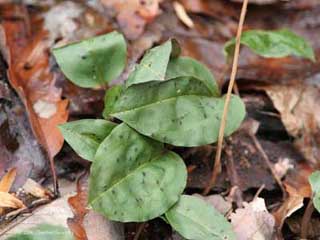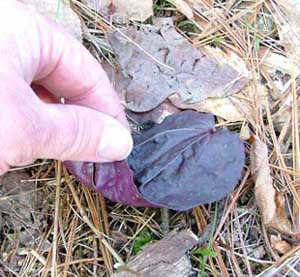What's Blooming
An online guide to what flowers are blooming
and other handy information about wildflowers in and around Bath County, Virginia.
Please feel free to email us and let us know what you are finding.
NEW: The What's Blooming Blog. Frequent post on local wildflowers and nature news.
Click to Goto the Blog
Winter Orchids
March – It is still winter here in the Allegheny Highlands of Virginia, but that doesn't mean the real wildflower fanatic can't find some interesting plants to hunt for and even some flowers in bloom.
Winter is the best time to find two species of native orchids that grow in our area. Both Puttyroot orchid (Aplectrum hyemale) and Crane-fly orchid (Tipularia discolor) have hibernal leaves. That is, the leaf (each plant has only one leaf) comes up in the fall, lives through the winter and dies back in spring. Puttyroot orchid blooms in the spring and sometimes a leaf is still around at bloom. Crane-fly orchid blooms in late July and early August and the leaves are long gone by then.
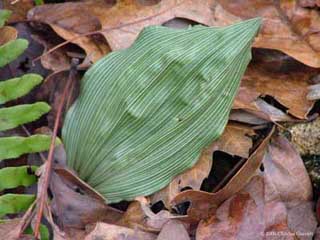 Both of these orchids have spikes of small flowers without bright colors, so they are easy to overlook when in bloom. The leaves, however, stand out against the mostly brown woodland of winter. Puttyroot has a distinctive and attractive green and white striped leaf that can be six inches of more in length. Also look for last years flower spikes which will now be brown to black with small capsules near the top. These spikes often persist a full year after the flowers fade though the capsules will have long ago opened and dispersed the thousands of tiny seeds. But these old stems are another helpful way to find Puttyroot during the flowering season and through the summer.
Both of these orchids have spikes of small flowers without bright colors, so they are easy to overlook when in bloom. The leaves, however, stand out against the mostly brown woodland of winter. Puttyroot has a distinctive and attractive green and white striped leaf that can be six inches of more in length. Also look for last years flower spikes which will now be brown to black with small capsules near the top. These spikes often persist a full year after the flowers fade though the capsules will have long ago opened and dispersed the thousands of tiny seeds. But these old stems are another helpful way to find Puttyroot during the flowering season and through the summer.
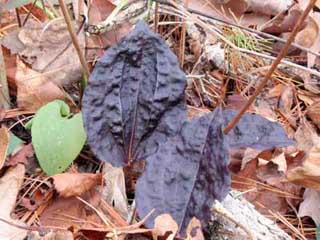
Crane-fly orchid leaves come in a number of color variations from all green on top to a solid dark purple. No matter what the top of the leaf looks like, the bottom of the leaf will be a distinctive beet color. Crane-fly orchid likes deeper, darker woodlands and is occasionally found along trails in the woods. But unlike Puttyroot, Crane-fly orchid is not likely to be found in more open road edge habitats.
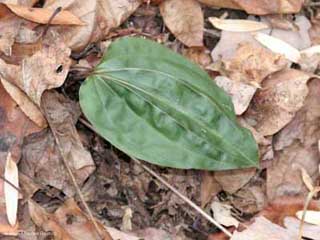 The seed capsules of Crane-fly orchid are smaller and lighter in color than Puttyroot and the stems don't persist as long. Still, a few may be found through the winter. By March, the Crane-fly leaves are rapidly beginning to whither, the winter growing season nearly over. The plant will rest until sending up a flower spike in July.
Like all of our native orchids, Puttyroot and Crane-fly orchids have a special relationship with a soil fungus. Where conditions are ideal, these plants may be found in large patches or over areas of many acres. But more often they are seen singly or in small groups. Crane-fly orchid is currently known from only one site in Bath County, along the Cobbler Mountain Trail in Hidden Valley. Native orchid plants should not be dug or picked. They seldom survive if transplanted.
The seed capsules of Crane-fly orchid are smaller and lighter in color than Puttyroot and the stems don't persist as long. Still, a few may be found through the winter. By March, the Crane-fly leaves are rapidly beginning to whither, the winter growing season nearly over. The plant will rest until sending up a flower spike in July.
Like all of our native orchids, Puttyroot and Crane-fly orchids have a special relationship with a soil fungus. Where conditions are ideal, these plants may be found in large patches or over areas of many acres. But more often they are seen singly or in small groups. Crane-fly orchid is currently known from only one site in Bath County, along the Cobbler Mountain Trail in Hidden Valley. Native orchid plants should not be dug or picked. They seldom survive if transplanted.
